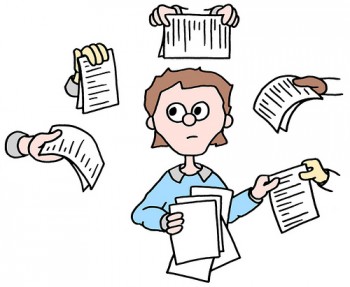Everyone’s a Writing Critic: Dealing with Writing Feedback
Everyone’s a Writing Critic: Dealing with Writing Feedback

Everyone’s a Writing Critic: Dealing with Comments and Corrections when Receiving Writing Feedback
Writing a solid first draft of something is genuinely difficult. It’s a herculean triumph of creativity and endurance over self-doubt (and procrastination – though the strategies I set forth in the first two posts in this series can make it easier to start writing and plow through to the first draft).
Unfortunately, “a solid first draft” is not the same as a finished, publishable piece. You have bosses, reviewers, and editors to deal with before your ultimate audience reads your deathless prose. These folks are going to read your “solid first draft” and give you comments.
Most comments are valuable and easy to fix: You wrote “millions” when you meant to write “billions.” It’s the “Wealth Management division,” not the “Wealth Management department.” Maybe you missed a subject/verb agreement or failed to catch a dangling modifier. Of course you welcome these comments; you’re glad to have the extra set of eyes on your work before it makes it way into the world.
And at least some of the comments you receive will be compliments: “Nice work” is manna from heaven for any writer. (Note to reviewers: No matter how much you hate a draft, find something to praise in it, or at least thank the writer for his or her efforts.)
But if all the comments you get fall into the categories of easy to fix or compliments, you are either a phenomenally gifted writer or no one cares enough to tell you the truth. The reality is that a serious writing project will probably come back to you in the form of a Word document peppered with tracked changes. It will be riddled with marginal notes. It will be accompanied by another set of ideas in the covering email that could just be boiled down to one two-word phrase: “Needs work.”
As the original writer, you will feel that all is lost, that your hard work has been for naught, perhaps even that your decision to become a writer was doomed from the get-go. There are dozens of things that can sap a writer’s confidence, but Word’s “Track Changes” feature may be among the worst.
Take a deep breath. All is not lost. Take comfort from the fact that you have a strategy for working through comments and rewriting your piece.
Step 1: Look at the Macro Comments First
Before you dive into the details, you want the 30,000-foot view – just as you do when you’re editing yourself. Read through the editor’s covering email and the marked-up copy to see if wholesale rewriting or restructuring is required. I like to recast the macro-level changes in notes to myself; it puts them top of mind and makes them easy to access. If a macro-change in tone is called for (“Make this more conversational…”), you’re going to have rework this line by line. But if a reviewer says something like “Perhaps the order of these sections could be improved,” then move paragraphs and sections around without rewriting (yet). The objective is to begin rewriting from a position of structural soundness.
Step 2: The Low-Hanging Fruit
This is a bit counterintuitive, but the next things to fix are the truly trivial ones: the missing commas or other minor grammatical issues, missing words, word choices, incorrect nomenclature, and errors of fact. For these, “Accept and move to next” (the next tracked change) is invaluable. But if a change requires any substantial thought or rewriting, don’t address it on this pass. Your real goal here is to start getting the document into shape for editing and rewriting.
Step 3: Clarifying the Opaque
After the first two editing steps, you should have a reasonably sound structure and a lot of the small things repaired, perhaps even most of them. Now you have to deal with the hard stuff: the most difficult and most opaque comments:
??? [with no clarification!]
Not sure about this…
Can you say this better?
When I was a young writer, I hated these kinds of comments with a vengeance. I wanted more transparency, more explicitness, more specificity. I wanted editors and reviewers to tell me what to fix and how to fix it.
I wanted, in other words, for them to do my job for me.
A writer should be so lucky. When your editor/boss/client says “???”, he or she is really saying, “I’m not wild about this word or sentence or paragraph, but I have no good idea about why, nor do I have any good suggestions about how to fix it.”
And that is perfectly fine. Their job is to tell you their reaction. Your job is to decipher that reaction and fix it.
So how do you do that?
First, accept the notion that your crystalline prose might be a bit opaque, or overwritten, or tone deaf, or just plain wrong. You’ve lived with the prose and the ideas behind it for hours, probably days, and perhaps weeks. You’re used to it, comfortable with it, invested in it. Which means you are no longer objective about your own writing. The reactions of other can be invaluable. Welcome them.
Second, don’t fix. Rewrite. Fixing is harder than rewriting. You don’t need to understand exactly why someone comments “???”. All you need to know is that something’s wrong in the prose: the rhythm or flow is off, the tone is out of sync from the rest of the piece, or this chunk feels out of place. (Let’s face it: If the change was trivial and factual – “the beta will be out in Q2, not Q3” – then your reviewer would just say that.)
Here’s how I rewrite at this stage:
- I leave the original text in place (with the comments visible for reference).
- I skip a line and start writing the paragraph again. Maybe I’ll frame it differently. Move thoughts or sentences around. Recast clauses. Strike an idea or passage entirely. I will sometimes parse every sentence in a paragraph (make that every clause) and see what the logical flow of the information should be, and start anew. My goal is simple: Make it different; make it clearer; make it better.
- Then I strike through the original text (with the strike through formatting button, not the “delete” command) and leave both in place for further perusal. That’s my visual reminder to look at the old versus the new.
Generally, making something different will make it better. You always want specific feedback and pointed comments, but you won’t always get them. Rewriting will make your work better, stronger, more supple, and more communicative.
Step 4: Edit for Flow and Copyedit for Perfection
By now, you’ve made the structural changes, fixed the minor comments, and rewritten the difficult or obtuse sections. Now’s the time to make your copy beautiful just as you did in the latter stages of editing your first draft: make it flow and make it perfect.
This falls into the category of tinkering. It requires thought and care, but the work isn’t difficult (and if it is difficult, it means you probably still have major work to do). A great strategy, especially as you’re learning to edit and rewrite, is to read the document aloud and use your phone to record your voice, then listen to the playback. Your voice and your ear will detect problems of flow, of clarity, of structure. Whenever you hear a too-long pause or you lose the audible flow, there’s probably an issue with the prose. If it’s awkward aurally, it will be awkward on paper too.
Your last stage is copyediting. Now you want to accept changes left and right until they are done and the document is as clean as a whistle. Then print it and review it line by line and word by word and make it perfect.
Dealing with the Unreasonable
Sometimes, you’ll get comments that are (a) wrong or ill-advised in terms of grammar or usage or (b) monumentally stupid with respect to the material or the goals of the piece. These comments will test your mettle as a writer – and as a diplomat.
As an example of the former: A client wants to use the word “actionable” to mean “capable of being acted on,” as in “the meeting generated several actionable ideas.” This meaning does have currency, but the true meaning of the word is its legal one: “giving a reason to bring an action or a lawsuit against someone.”
I’m old school on this one and won’t use the word in its more contemporary parlance. But I won’t categorically overrule someone for this. I’ll either recast the sentence to avoid the word entirely or explain that “actionable” is primarily a word with negative connotations: You don’t want a reader to think that “the meeting generated several ideas that could lead to lawsuits.”
Much more serious is the second category of bad comments, when a reviewer makes a suggestion that is just plain dumb. Examples might include inserting a really bad or inappropriate or reference. Sometimes, a non-writer will recommend using a cliché or a cheesy call to action that will make the person or company look bad. It’s your job to explain why something is inappropriate or unwise.
It helps if you have defined things like voice and tone (“our firm will always sound confident but never sound arrogant”). Then you can easily demonstrate why a suggestion is at odds with that voice and tone. But if not, you must convincingly (and diplomatically) push back:
This is at odds with the spirit and purpose of this project.
I worry that our clients would feel we’re being condescending here.
This whitepaper is overly promotional; this isn’t the vehicle for a hard sell.
You earn your salary by writing well; you earn stature and respect by thinking and behaving as a strategist.
Ultimately, learning to deal with comments and criticism is an issue of mindset. Learn to enthusiastically embrace editing and rewriting as key components of the writing/approval/publishing process. You want the best possible product, and good reviewers can very much help you get there. In fact, they will help you get there faster than you could on your own.
Emotive Brand is a San Francisco brand strategy firm.






